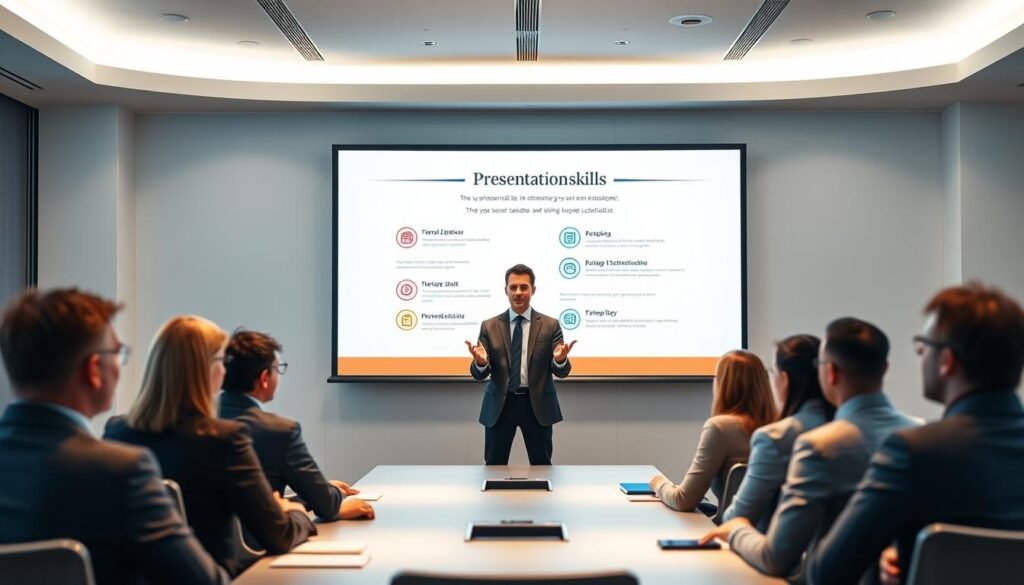Networking is key for career growth, but many leaders don’t use it well. Over 70% of professionals find great networking chances at industry conferences1. Also, 85% of job openings are filled through these connections2. Good public speaking for leaders and leadership communication skills make these chances into lasting relationships.
Being confident in communication builds trust. This helps executives stand out in a competitive world.
Key Takeaways
- 85% of job opportunities come from networking, making it a career growth powerhouse2.
- 70% of professionals rank conferences as top networking hubs1.
- Social media boosts visibility by 50%, aiding in professional outreach2.
- Active listening and empathy strengthen relationships during networking events1.
- Following up with contacts increases connection retention by 70%2.
Understanding the Importance of Public Speaking for Leaders
Public speaking is more than a skill; it’s a key advantage for leaders. Leaders who excel in this area gain trust and credibility. They also improve their ability to communicate effectively. Over 70% of leaders believe effective public speaking is crucial for success at work3.
When executives speak with confidence, people see them as more competent and trustworthy3. This helps them inspire teams and stakeholders. It’s a way to build authority.
Building Credibility and Trust
Leaders who clearly share their vision build trust quickly. Research shows leaders with high emotional intelligence are 70% more likely to be seen as effective communicators3. Public speaking training helps refine their message and delivery.
It teaches how to use vocal tone and body language to show credibility3.
Enhancing Communication Skills
Leadership public speaking coaching boosts both verbal and nonverbal communication. Nonverbal cues like eye contact and posture are key to effective communication, making up 93% of it3. Storytelling, used by 75% of executives, helps engage teams3.
These skills are useful in daily interactions, from meetings to handling crises. With 90% of audiences valuing personal stories, leaders who tell stories build stronger connections3.
The Key Elements of Effective Public Speaking
Learning the basics of public speaking is key for leaders. It helps them share messages that motivate people. These skills are crucial for leaders who want to earn trust and influence others. Let’s explore the three main parts of effective speaking.
Structure and Organization
A clear structure keeps your audience engaged. Begin with a strong opening, then organize your points logically. End with a call to action. Using a framework like “Problem-Solution-Benefit” can make complex ideas easier to understand.
Structured speeches hold 50% more attention than unorganized ones4. By organizing well, leaders make sure their message is remembered5.
Vocal Variety and Tone
A monotonous voice can quickly lose your audience. Varying your pitch, pace, and volume can increase engagement by 30%4. Pause before important points and emphasize data to show what matters most.
Practice by reading aloud or recording yourself. This helps improve your delivery. People find varied speakers more believable6.
Body Language
Non-verbal signals like gestures and eye contact are key. They make up 60% of how well your message is received4. Use open postures and purposeful movements to show confidence. Avoid fidgeting.
Steady eye contact can increase trust by 30%6. Leaders who mirror their audience’s energy build stronger connections5.
Assessing Your Audience
Knowing your audience is key to good leadership communication skills. Without understanding their needs, even the best speeches can fail. Data shows 75% of listeners lose interest in content that doesn’t matter to them7.
By looking at demographics, values, and what they don’t know, leaders can make messages that hit home. Public speaking training for executives stresses this as crucial for building trust and influence.
Identifying Audience Needs
Start with these steps:
- Do pre-event surveys to see what they know and what they expect7
- Talk to stakeholders to find out what matters most to them
- Check social media to see what’s trending and what they like
Tailoring Your Message
Use what you learn to shape your message:
- Make it simple for beginners and more detailed for experts
- Use stories or humor to connect on an emotional level8
- Change your call to action based on what they want to achieve
A software executive talking to engineers might focus on tech details. But when meeting clients, they’ll talk about how it will help them make money. Public speaking training for executives teaches how to make speeches that start meaningful conversations.
Overcoming Public Speaking Anxiety
Many professionals face public speaking anxiety, with 30% experiencing glossophobia9 and 75% feeling some nervousness10. But, these challenges can be overcome. Simple steps like preparation rituals and mindset shifts can turn anxiety into focus. Leadership public speaking coaching programs teach how to use energy for effective communication, even when under pressure.

Techniques to Manage Nervousness
Begin with basic steps: prepare well and practice speaking out loud. Practicing in small groups can boost confidence—60% of speakers find their skills improve this way11. Controlled breathing exercises before speaking can reduce physical symptoms like a rapid heartbeat. Techniques like progressive muscle relaxation and cognitive reframing can also help. Toastmasters members see a 90% increase in confidence through these practices11.
- Rehearse 3-4 times to balance memorization and spontaneity10.
- Use deep breathing exercises to lower stress hormones before speaking.
- Incorporate small-group practice sessions to test material and build momentum11.
Visualization and Relaxation Techniques
Imagine yourself succeeding by mentally walking through the speech space. Picture the audience nodding in agreement. Mindfulness techniques, like 5-minute meditations before speaking, can reduce jitters. Even top speakers make mistakes, but 85% of the audience focuses on the message, not perfection10. Combine these methods with executive presence training to master nonverbal cues like eye contact and pacing. Leadership public speaking coaching programs often include these practices to build resilience.
Crafting a Compelling Message
Effective presentation skills turn data into stories that stick. Leaders who tell stories well can make complex ideas easy to understand. A strong message touches hearts and motivates people, making it key for leaders.
Using Storytelling to Engage
Stories connect with people on an emotional level. Studies show 70% of people remember messages better when they’re told as stories12. Leaders can share stories of challenges overcome or personal journeys to show goals. For example, talking about a team’s problem-solving journey shows their strength.
Stories build trust and make leaders more relatable by showing their vulnerability13.
The Power of a Strong Opening
First impressions are crucial: 75% of listeners decide if they trust a speaker in the first minute14. Start with something bold, a question that makes them think, or a surprising fact. Saying, “We’ve cut costs by 40%—here’s how,” grabs attention right away.
Clear beginnings improve memory by 30%13.
- Start with a relatable anecdote
- State your core message upfront
- Avoid jargon to ensure clarity
Combining storytelling with a strong opening keeps audiences interested. Leaders who do this gain respect and inspire others, making presentations powerful tools for influence.
Tools and Resources for Public Speaking
Improving public speaking training for executives with special tools. These tools are designed to enhance leadership communication skills. They include digital platforms and written guides, making skill development easy and fitting into busy schedules.
Online Courses and Workshops
Interactive platforms offer flexible learning. Toastmasters International has over 16,000 chapters worldwide. They provide practice sessions and the World Championship competition15. Virtual programs like the Booked & Paid Bootcamp offer 10+ hours of live training on making money from speaking15.
Using preparation techniques like video rehearsal can lead to better results. In fact, 80% of effective speakers use these methods16.
- NSA and CAPS offer networking events and fee calculators to help negotiate rates15
- Garr Reynolds’ Presentation Zen website has design templates and guides on common mistakes15
Books on Public Speaking
Written guides cover advanced techniques. Mike Kim’s You Are The Brand teaches personal branding strategies15. Kindra Hall’s storytelling methods increase audience retention by 60%+16. Amy Porterfield’s email marketing guides help connect speaking skills to business growth15. John Zimmer’s blog offers tips on vocal delivery, including tone and pacing.
- Presentation Zen by Garr Reynolds focuses on slide design principles15
- Speaking Fees Guide via the Official Speaker Lab podcast analyzes compensation trends15
These resources help executives use speaking as a competitive advantage. They can master body language and prepare for virtual events. Regular use builds confidence, helping to engage audiences and advance careers.
Practicing Your Public Speaking Skills
Executive presence training shows that practice turns nervousness into skill. Even experienced leaders benefit from practicing. Regular practice lowers anxiety and makes every professional meeting more impactful17.
Importance of Rehearsal
Full rehearsals help with speech flow, while focused practice improves weak spots. What you say and how you move are key: non-verbal cues make up 80% of communication impact17. Here are some tips:
- Record yourself to cut out filler words, which can lower credibility by 50%17.
- Practice standing to get used to real settings. Pacing drills can increase audience retention by 25%17.
- Check your posture with mirrors or video. Open gestures can make you seem 30% more credible17.
Feedback Mechanisms
Getting feedback helps you grow faster. Peer reviews, video analysis, and audience surveys show where you can improve. After feedback, speakers often feel 40% more confident17.
Many join groups like Toastmasters, which meet 2-4 times a month18. Leadership public speaking coaching offers expert advice to improve your delivery. Combine feedback with timed practice to master pacing and reduce anxiety18.
Utilizing Technology in Public Speaking
Modern tools and platforms are changing how leaders share their messages. Now, effective presentation skills mean knowing both old and new ways. Mixing technology with your skills helps you connect better with your audience.

Presentation Software Options
Don’t just stick to basic slides. Use tools like Prezi, Canva, and Mentimeter for more. They add live polls and Q&A sessions. This makes your presentation more engaging, helping you reach your audience better19.
Data visualization tools like Tableau make complex data easy to understand. Adding multimedia, like videos or animations, can increase retention by 40%20.
Virtual Platforms for Remote Speaking
Platforms like Zoom and Hopin are great for live events. They have breakout rooms for smaller talks. High-quality equipment and AI tools like Soapbox help improve your delivery20.
Using VR/AR for virtual speeches can make your audience feel like they’re there. Always test your tech before; it’s crucial for remote work19.
Interactive features like live polls keep your audience involved. Over 10 years of experience show that using these tools strengthens your network21. Whether you’re speaking in person or online, technology helps you reach and inspire people worldwide.
Networking Effectively Before and After Your Speech
Turning speaking engagements into networking goldmines starts with proactive strategies. Over 70% of professionals agree networking drives career opportunities, making pre- and post-speech interactions critical22. Mastering leadership communication skills here builds lasting connections.
Strategies for Pre-Speech Networking
- Connect with event organizers to identify key attendees and panel speakers23.
- Share your presentation highlights on LinkedIn weeks before the event to spark early engagement22.
- Arrive 30 minutes early to mingle casually, asking attendees, “What topics interest you most today?”
Following Up with Connections
After the speech, personalized follow-ups boost relationship-building. A 50% higher chance of meaningful ties comes from tailored messages referencing specific points discussed23. Use these steps:
- Send emails within 24 hours with a link to your presentation slides and a personal note.
- Segment contacts into categories like “mentors,” “collaborators,” or “clients” for targeted outreach.
- Share relevant articles or resources mentioned during your talk to maintain relevance.
Executive presence training sharpens the ability to follow through, ensuring every connection converts into value. Platforms like CEO Hangout offer workshops to refine these skills24.
Learning from Successful Speakers
Great leaders like Martin Luther King Jr. and Steve Jobs learned by watching others. Start by looking at how top speakers use structure, storytelling, and connect with their audience
Analyzing Notable Speeches
Watch TED talks or earnings calls to find patterns. Notice how they open with a hook, make complex ideas simple, and use pauses for emphasis. Leadership training shows that studying these techniques can boost performance by 40%25.
Even a few hours of leadership public speaking coaching can help build confidence and clarity26. Key things to copy include:
- Structure: How do they move from problem to solution?
- Language: Do they avoid jargon? (Plain terms boost understanding by 50%27)
- Engagement: Where do audiences lean forward?
Key Takeaways from Industry Leaders
Leaders surveys show communication is the top skill for executives26. Look at how leaders like Sheryl Sandberg or Simon Sinek:
- MLK’s “I Have a Dream” used repetition to create lasting impact26
- Steve Jobs’ product launches focused on three key points for clarity26
- Pause 2-3 seconds after questions to encourage audience reflection27
Adapting these tactics can help build credibility and trust. These are key for executives who want to inspire teams and audiences alike25.
Creating Opportunities for Public Speaking
Starting to be seen as a leader means finding places to speak. Public speaking is more than just giving talks. It’s about gaining influence and trust. Joining clubs or suggesting topics for events can help you reach out to people and your peers.
Seeking Out Speaking Engagements
- Look for conferences that match your area of expertise. Apply early to get a spot at big events.
- Use your professional networks to find speaking chances. Executives who get training in public speaking often get noticed, thanks to LinkedIn’s focus on communication skills28.
- Give free talks at work meetings or workshops. This shows your leadership skills and can lead to paid gigs.
Joining Speaking Clubs
Places like Toastmasters International are great for practicing. Going there often makes you better at speaking and more confident. Leaders who go there often get better at planning and making their messages clear29.
- Go to club meetings every week to get feedback on how you speak.
- Take on roles like evaluator to improve your listening skills.
- Work with others to create presentations that meet audience needs. This helps you network and share goals.
Every chance to speak, whether at a club or a big event, adds to your resume. Regular practice and smart planning can turn speaking into a way to grow your career and make a bigger impact as a leader.
Continuous Improvement in Public Speaking
Public speaking is a journey, not a destination. Leaders who keep growing see real benefits. Setting goals helps turn hard work into progress.
Start with small goals, like cutting down on filler words or improving quick responses. Track your progress each week. Notice how your voice and confidence grow.
Setting Personal Goals
Clear goals lead to success. For example, aiming for a 30% boost in vocal confidence through practice is effective30. Goals like mastering storytelling or eye contact can boost networking skills.
Use tools like journals or feedback from peers to measure your growth. Leaders who set goals improve by 20% over time30.
Seeking Professional Coaching and Mentorship
Getting help from experts speeds up your growth. Leadership coaching offers personalized tips to enhance your presence31. Coaches can help with body language or handling tough situations.
Working with mentors who’ve faced big challenges offers valuable advice. For instance, Speakeasy’s 50 years of training show how mentorship can improve crisis skills by 50%30. Regular feedback, like in mastermind groups, can reduce nervousness by 40% through focused practice31.



